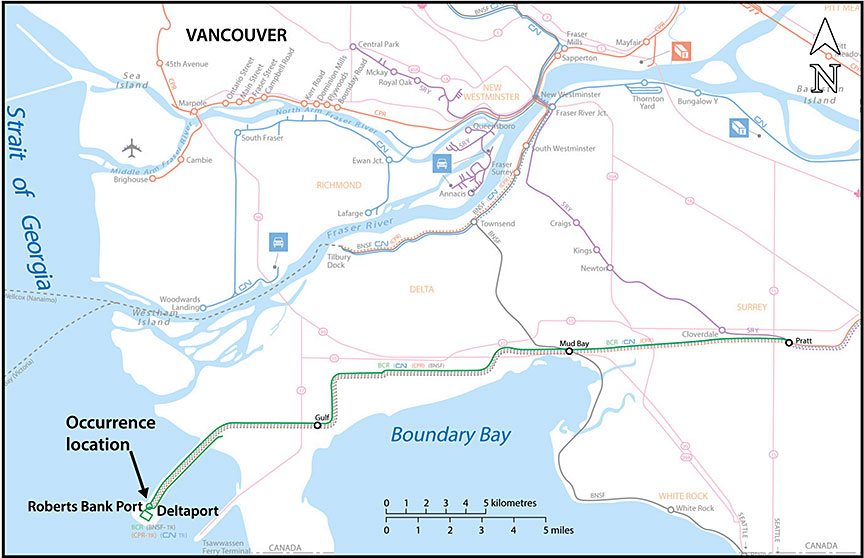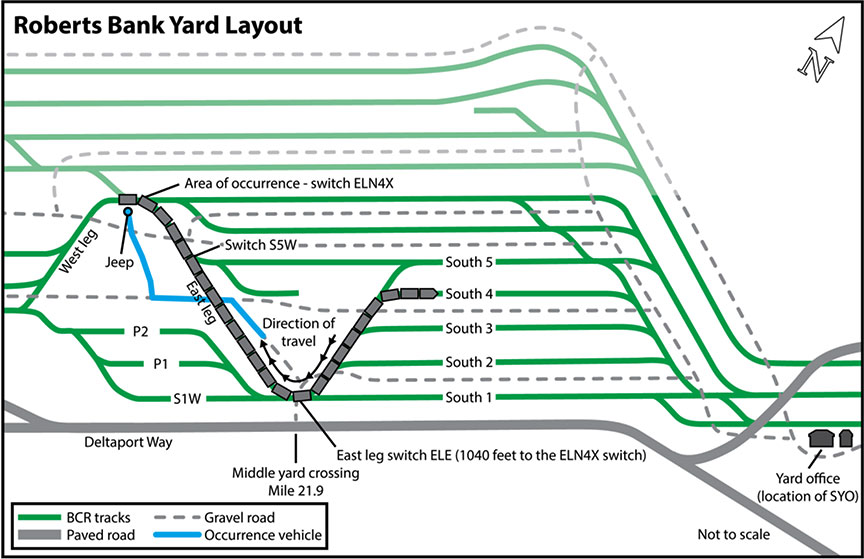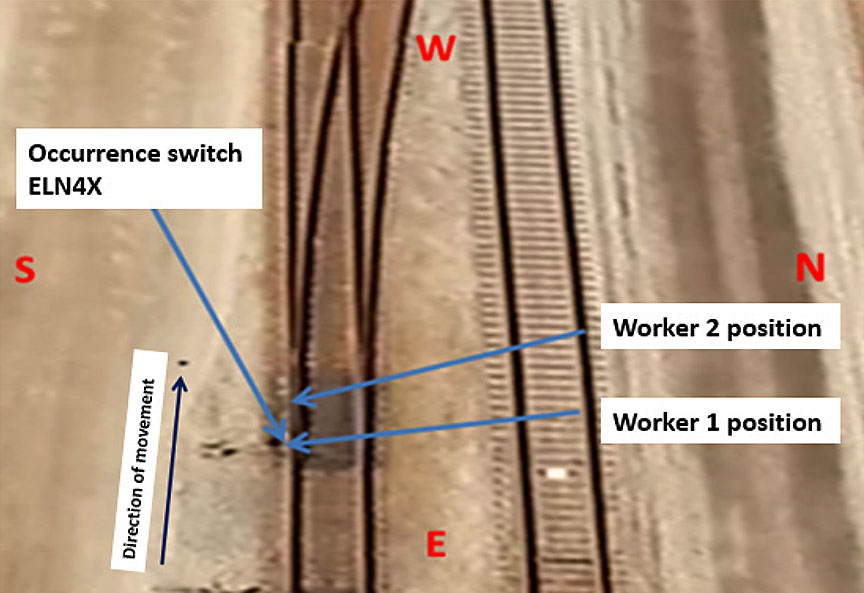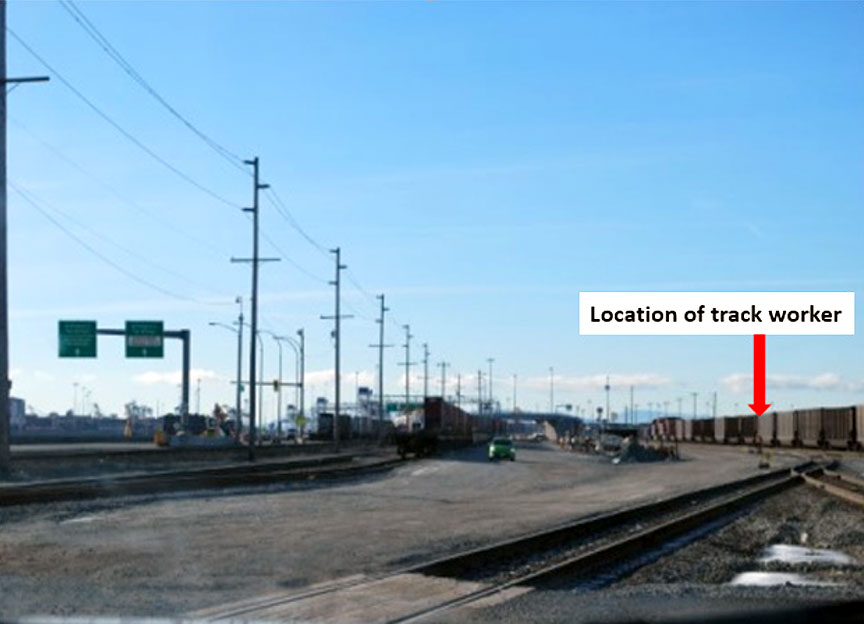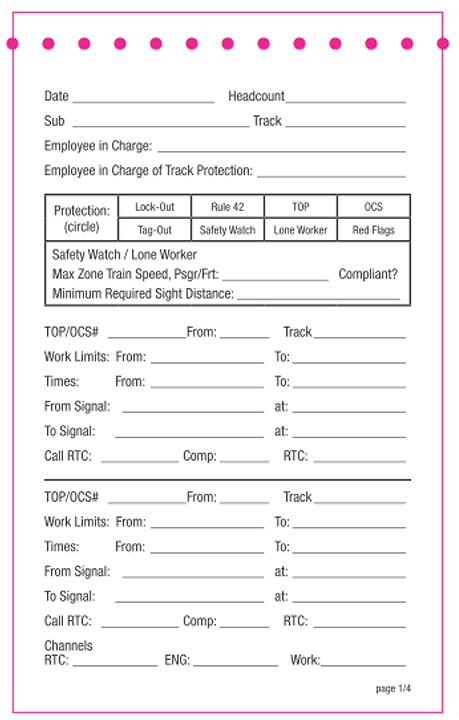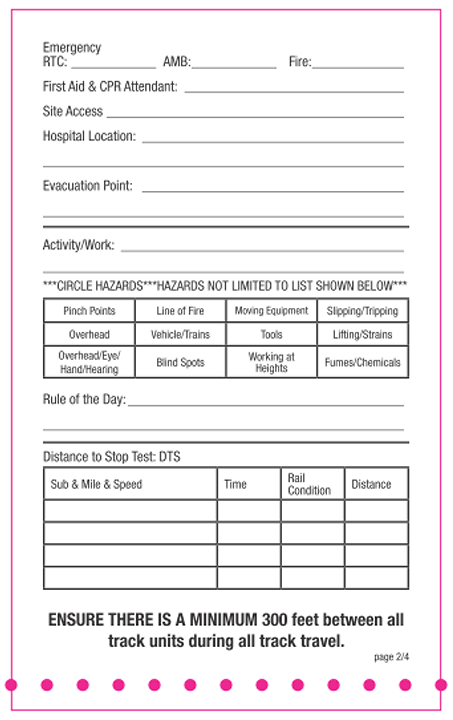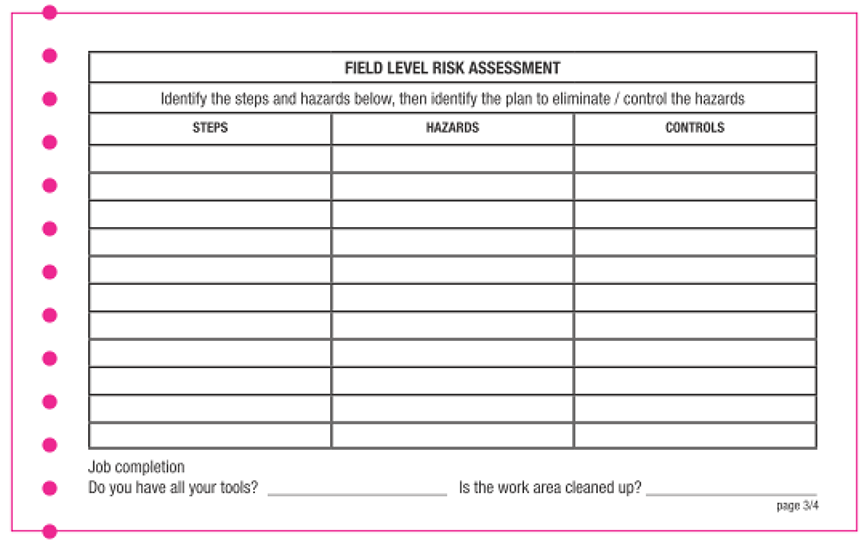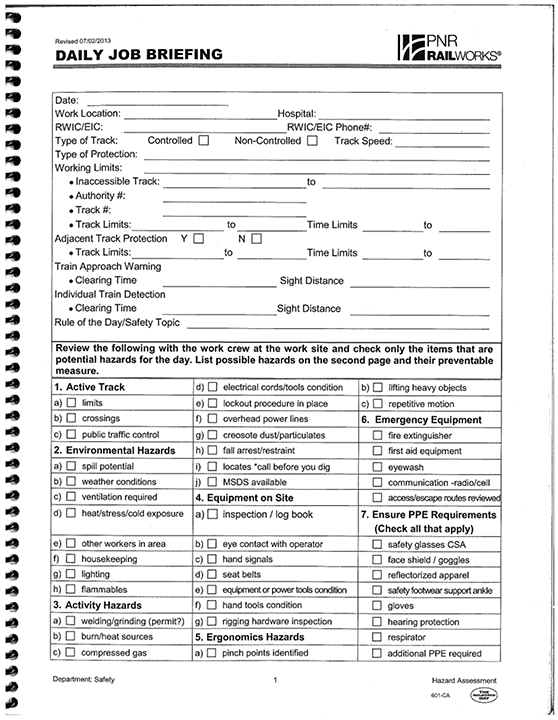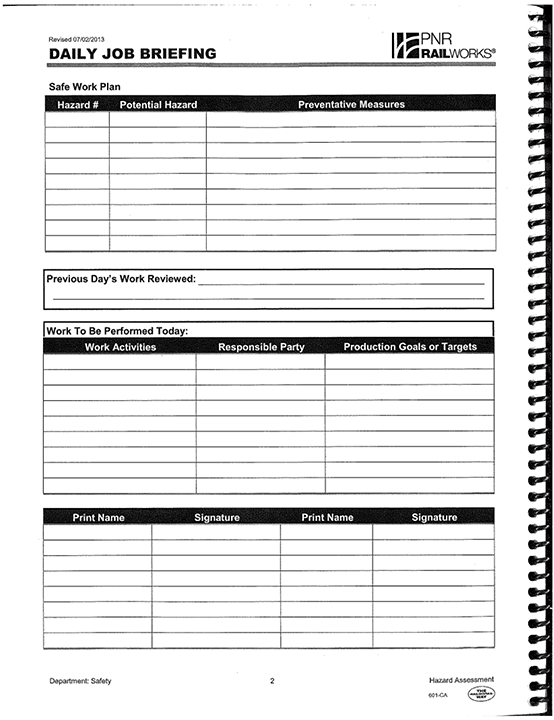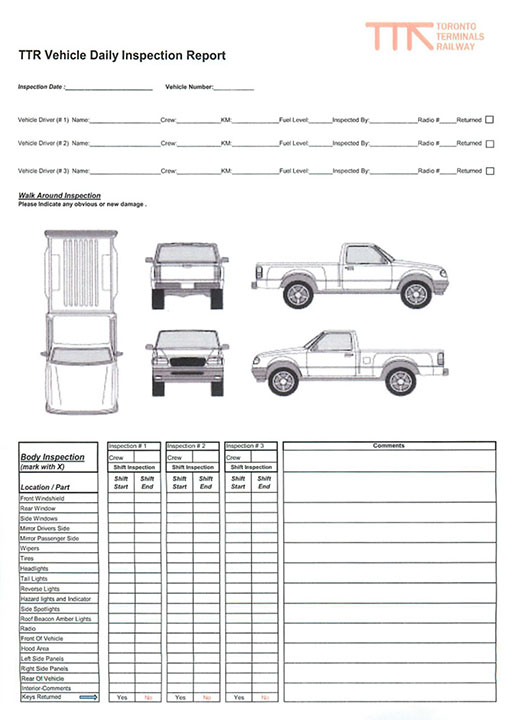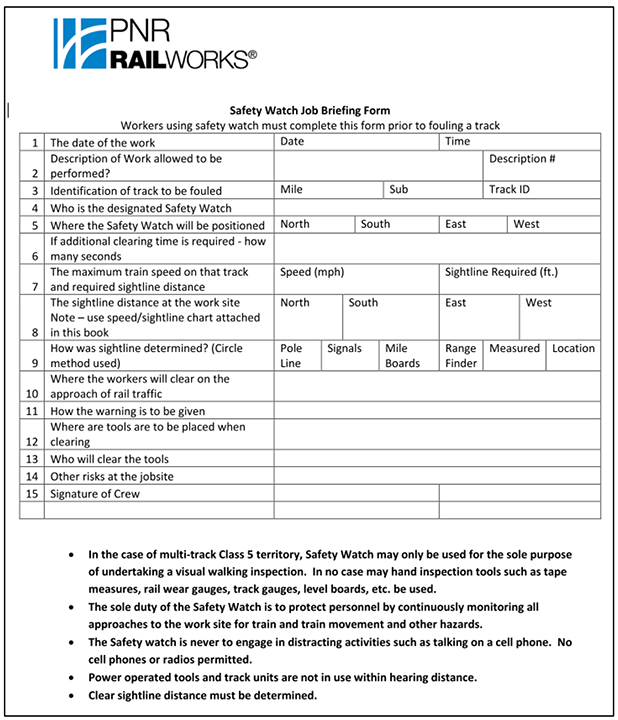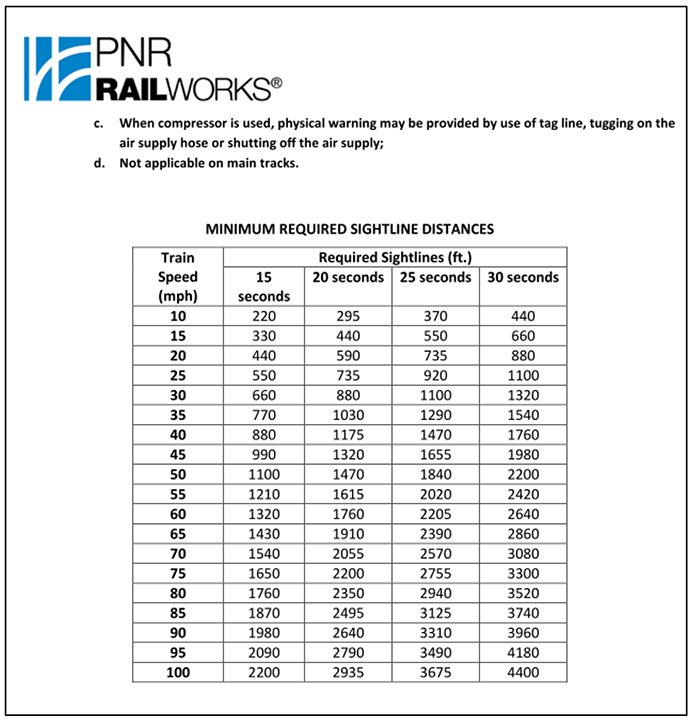Employee injury
BCR Properties Ltd.
Roberts Bank Yard
Mile 16.8, Port Subdivision
Delta, British Columbia
The Transportation Safety Board of Canada (TSB) investigated this occurrence for the purpose of advancing transportation safety. It is not the function of the Board to assign fault or determine civil or criminal liability. This report is not created for use in the context of legal, disciplinary or other proceedings. See Ownership and use of content. Masculine pronouns and position titles may be used to signify all genders to comply with the Canadian Transportation Accident Investigation and Safety Board Act (S.C. 1989, c. 3).
Summary
On 18 December 2016, at about 1200 Pacific Standard Time, a Toronto Terminals Railway switching crew was shoving 66 empty intermodal platforms onto the east leg track at Roberts Bank Yard in Delta, British Columbia. At the same time, 2 PNR RailWorks track workers were clearing snow from a switch on the same track. One of the track workers was struck by the leading platform of the movement and was transported to hospital with serious injuries.
Le présent rapport est également disponible en français.
1.0 Factual information
1.1 The occurrence
At 0530Footnote 1 on 18 December 2016, at Roberts Bank Yard (the yard) in Delta, British Columbia (Figure 1), the crew members of the Toronto Terminals Railway (TTR) 0530 Deltaport Switcher reported to the BCR Properties Ltd. (BCR) supervisor of yard operations (SYO) to receive their switching instructions for the day. The crew consisted of a locomotive engineer (LE) and a conductor.Footnote 2 Throughout the morning, the crew performed various switching activities in the yard.
At about 1154, while performing switching activities in track P2, the conductor noticed some track workers in the vicinity of the ELN4X switch on the east leg track (Figure 2).
A PNR RailWorks (PNR) track maintenance crew had been called to clear snow from switches after a recent snowfall. The track maintenance crew consisted of 2 track workers and a lead hand, who was scheduled to arrive later in the day. When the 2 track workers arrived at the yard at 0930, the BCR supervisor of yard operations gave them instructions on the order in which the switches were to be cleared of snow. The track workers cleared a number of switches at the east end of the yard in the morning. At about 1115, during their lunch break, the lead hand arrived.
At about 1152, the 2 track workers proceeded to the ELN4X switch. The hand-held radios issued to the track workers had been left in the truck, and the truck radio loudspeaker was not used, because the truck was thought to be too far away for the workers to monitor any TTR switching movements.
At about 1159, the lead hand departed for a health break while the 2 track workers began their work on the switch. One worker (track worker 1) shovelled snow from under the switch adjustment rod that connects the switch points to the switch stand. The other worker (track worker 2) swept snow from the switch points (Figure 3).
At about 1200, with the tail end of a 66-platformFootnote 3 movement (4000 feet in length) stopped just east of the east leg switch (ELE), the conductor lined the switch for the east leg track and instructed the LE to shove back. No specific distance was specified. The LE acknowledged the instruction to back up and began shoving the cars westward. The crew's intention was to continue shoving until the leading 22 platforms cleared the S5W switch. From his position at the controls of a vehicle travelling ahead of the leading car of the movement, the conductor had an unobstructed view of the ELN4X switch about 1040 feet to the west.
The conductor manoeuvred the vehicle across the east leg, crossing to the south side of the east leg track, and positioned the vehicle beside and just ahead of the leading car of the movement. As the leading car approached the east leg crossing,Footnote 4 the conductor instructed the LE to continue shoving westward. The LE did not reply to the conductor and continued shoving westward. While shoving, the LE, positioned in the locomotive at the opposite end of the movement, was not able to see the leading car.
The conductor did not inform the LE that there were track workers on the track ahead of the movement. When the leading car of the movement was about 500 feet away from the track workers, the conductor activated the yellow oscillating beacon on top of the vehicle to alert the track workers to the approaching movement. The conductor's past experience had been that track workers in the yard would clear the track about 15 seconds before a movement arrived. After no reaction was observed from the track workers, and when the leading car of the movement was about 400 feet from the ELN4X switch, the conductor attempted to sound the vehicle's horn. However, the horn was inoperative. The conductor then communicated to the LE to stop. The movement was placed in emergency, and the locomotive independent brake was applied. However, the movement was unable to stop before the leading platform struck and seriously injured track worker 2.
1.2 Recorded information and crew observations
Recorded information from the locomotive event recorder (LER)Footnote 5 was reviewed, along with the video recording of the switching movements from a yard camera. The collision with the track worker was out of view of the yard camera.
Table 1 provides a detailed sequence of events of the occurrence.
| Time | Event |
|---|---|
| 1153:57 | The movement stopped after coupling 44 platforms onto 22 platforms in track P2. |
| between 1153:57 and 1155:05 | The conductor exited the vehicle, cut in the air brakes on the movement, and then released a hand brake. He noticed that track workers were in the vicinity of the ELN4X switch. The conductor returned to the vehicle. |
| 1156:28 | The locomotive began to move forward, pulling the cut of 66 platforms. |
| approx. 1157 | The conductor drove back to the east leg (ELE) switch located on the South 1 track. |
| 1158:42 | The lead hand of the PNR maintenance crew departed from the work site at the ELN4X switch for a health break. |
| between 1159:09 and 1159:24 | The movement came to a stop east of the ELE switch on the South 1 track. The conductor lined the ELE switch for the east leg track and then re-entered the vehicle. |
| 1159:33 | The conductor started driving west on the gravel road on the north side of the east leg track. |
| 1159:44 | The locomotive began backing up, shoving the 66 platforms, after being instructed by the conductor to back up toward the ELN4X switch. The movement was being shoved with the air brakes released. |
| 1200:19 | The conductor crossed from the north side to the south side of the east leg track and continued driving westward ahead of the movement. While driving, the conductor instructed the LE to continue shoving. The movement was travelling at about 11 mph. |
| 1200:40 | The conductor activated the yellow oscillating beacon on top of the vehicle. |
| approx. 1201 | After realizing that the track workers were not aware of the approaching movement, the conductor attempted (unsuccessfully) to sound the vehicle horn to warn the track workers. |
| approx.1201:04 | The conductor rolled down the driver's side window of the vehicle and yelled, attempting to get the track workers' attention. |
| approx.1201:08 | The conductor instructed the LE to stop the movement. |
| 1201:11 | The LE initiated emergency braking. |
| 1201:15 | Travelling at 11 mph, the movement struck track worker 2. |
| 1201:24 | The movement came to a stop. |
1.3 Roberts Bank Yard
Roberts Bank Yard is located on the Port Subdivision between Mile 16.8 and Mile 23.9. This yard services the Westshore Terminals coal port as well as the Global Container Terminals. BCR owns both the Port Subdivision and Roberts Bank Yard. The Port Subdivision is controlled by the BCR rail traffic controller, while all operations within the yard are controlled by the BCR supervisor of yard operations. The Canadian Rail Operating Rules (CROR)Footnote 6 govern both the yard and the Port Subdivision.
BCR contracted track maintenance work on the Port Subdivision and within the yard to PNR, which provided the workers, equipment, and expertise to accomplish the track maintenance requirements. While supervision of PNR was provided by BCR's track and facilities maintenance staff, PNR primarily administered training, safety monitoring, and discipline.
TTR is jointly owned by Canadian National Railway Company (CN) and Canadian Pacific Railway. TTR provided switching operations within the yard. The TTR switching crews reported to the BCR supervisor of yard operations to receive their switching assignments and daily job briefings. The SYO communicated any changes or updates to these instructions to the TTR switching crews. Although TTR switching crews were supervised in the yard by the BCR supervisor of yard operations, TTR provided training and efficiency testing, conducted safety meetings, investigated incidents involving TTR employees, and administered discipline.
BCR operations are regulated by the BC Safety AuthorityFootnote 7 Railway Division. PNR activities are regulated by WorkSafeBC. TTR switching operations are regulated by Transport Canada (TC).
1.4 Crew information
1.4.1 Toronto Terminals Railway switching crew
The TTR switching crew comprised an LE and a conductor. The LE had worked for TTR for 7 years. Before joining TTR, the LE had 26 years of service with various railways. The conductor had 7 years of service with TTR and 39 years of service with CN. Both crew members had worked at Roberts Bank Yard for the duration of their TTR service.
Both crew members were qualified to perform the duties of their positions, were familiar with Roberts Bank Yard, and met regulatory work and rest requirements. They worked regularly scheduled shifts in the yard and occasionally worked overtime. Both crew members were rested, and neither reported any difficulty with alertness on the day of the occurrence.
TTR switching crews received 3 days of recertification training every 3 years. This training was contracted to a third party, which provided 2 days of training on the CROR, the safe handling of dangerous goods, and TTR's General Operating Instructions. WorkSafeBC provided an additional day of training on Occupational First Aid Level 1. The LE and the conductor were due for recertification training on 04 November 2017.
1.4.2 PNR RailWorks track maintenance crew
The PNR track maintenance crew comprised 2 track workers and a lead hand.Footnote 8 Track worker 1 had been employed by PNR for 10 years at Roberts Bank Yard and on the Port Subdivision. Track worker 2 had been employed by PNR for about 10 years, with 4 years in Alberta and 6 years at Roberts Bank Yard and on the Port Subdivision. The lead hand had been employed by PNR for 11 years, with 9 years on the Port Subdivision and at Roberts Bank Yard.
All 3 track maintenance employees were considered by PNR to be qualified to perform the duties of their positions, and they were familiar with the yard and the Port Subdivision. They worked regularly scheduled shifts and had worked no overtime the week of the occurrence. Track maintenance workers are not subject to regulatory work and rest requirements. Both track workers and the lead hand reported being rested and fit for duty at the beginning of their respective shifts.
1.5 Safety watch
In the 1990s, safety watch protection emerged as a form of track worker protection on North American railways. As a procedure, it was designed to improve track worker productivity, especially at locations with increased traffic and reduced track time.
In 2001, when CN adopted the use of this type of track worker protection, written guidelines were established within CN's General Engineering Instructions (GEI). These guidelines were revised in 2006, 2009, 2011, and 2013. CN recertifies its engineering employees every 3 years. This recertification includes training and evaluation on safety watch.
Section 3.4 of the GEI states (in part):
All engineering employees required to foul or occupy tracks must be protected by one of the following means:
- Positive protection as per the CROR
- Safety Watch protection
- Lone worker protectionFootnote 9
Section 5.0 of the GEI states (in part):
5.1 Work that is performed on or about the track that does not require positive protection as provided by the Canadian Rail Operating Rules (CROR) may be performed using Safety Watch Protection. […]
A list of work that can be undertaken under Safety Watch is provided in Table 2.
Duties of Safety Watch
5.2 The sole duty of the Safety Watch is to protect working personnel by continuously monitoring all approaches to the work site for train and track unit movements or other hazards. The Safety Watch must dedicate their entire attention to this task and never engage in distracting activities, such as talking on a cell phone, text messaging, browsing, etc. In addition, they are never to engage in any other distracting activities, including the work being undertaken. […]
Clear Sightline Distance
5.5 Safety Watch protection will NOT be considered as adequate protection where sightlines, train speeds, weather conditions, restricted clearing ability, etc., do not allow sufficient time for each worker being protected to move to and occupy a previously arranged place of safety not less than 15 seconds before a train moving at maximum speed for that track, reaches that point. Should more time be required to clear the track, it must be added to the 15 seconds.
Example: Employees working under Safety Watch protection on a track where the maximum train speed is 35 mph (56 km/hr). It is determined that it will take the employees 5 seconds to clear themselves and their tools from the track and be in a place of safety after being warned of an approaching train. This 5 seconds must be added to the 15 seconds indicated above. Therefore, from the table below, the clear sight lines required are found under the 20 second column for a train speed of 35 mph (56 km/hr), or 1030 feet (314 meters) of clear distance in either direction.
5.6 Table 3 indicates the required distance by which time employees and their tools must be completely in the clear and in a safe location for trains traveling various speeds.Footnote 10
For safety watch, there is no specific requirement in the GEI relating to whether track workers using this protection must carry a radio.
Appendix A of this report contains information about the type of work permitted under safety watch and the minimum required sightline distances.
An alternative to safety watch for protecting track work on non-main track is CROR Rule 841, Protection of Track Work on Non-Main Track and in Cautionary Limits. This rule permits the use of red flags and red lights between the rails 100 yards from the working point in either direction, or the use of special locksFootnote 11 on switches lined to prevent access to the working point. A combination of red flags and special locks is also permitted.
1.6 Implementation of safety watch by PNR RailWorks
In 2007, PNR began using safety watch as a form of track worker protection at Roberts Bank Yard, adopting the use of CN's GEI. The track workers were expected to apply those instructions when working at the yard. PNR also had guidance in its Job Briefing Manual on the use of safety watch, including the required sightline distance chart.
At Roberts Bank Yard, safety watch was the method of protection employed for the snow-clearing work being performed at switches. In this occurrence, both track workers were removing snow at the switch with the intention of performing safety watch duties simultaneously. The 2 track workers and the lead hand believed that they could all remove snow from switches while simultaneously performing the requirements of the safety watch.
1.6.1 Training of PNR RailWorks track workers for safety watch
PNR's supervisors received training on CN's 2013 GEI, which included sections on safety watch, and completed an online training course and exam. The supervisors were expected to disseminate the information learned about safety watch to the track workers during job briefings or tailgate meetings. There were no records to indicate that the track workers involved in this occurrence had received this training.
Of the 3 PNR track workers, only track worker 1 had received training on safety watch. This training was accomplished through an in-classroom review of CN's 2013 GEI, which included safety watch. However, the review did not include a comprehension test of the safety watch material.
1.7 Job briefing requirements at PNR RailWorks
PNR's Job Briefing Manual provided guidance to employees on the proper conduct of job briefings. In addition, Section 6.4 of PNR's Health and Safety Manual states (in part):
Footnote 12PNR applied Section 2.0, Job Briefing, of the 2013 GEI. This section states (in part):
2.1 Prior to commencing any work, the employee in charge of a work group will hold a job briefing session for all persons engaged in the activity.
2.2 A supplemental job briefing is required when:
- Method of protection is changed, or
- Method of protection is extended or about to be released.
- Job task is changed.Footnote 13
Subsection 2.4 of CN's GEI states:
Footnote 14With respect to job briefing requirements when safety watch protection is used, subsection 5.3 of CN's GEI states:
Prior to implementing Safety Watch protection, the employee in charge, the Safety Watch and the employee(s) being protected must conduct a thorough job briefing to ensure that at a minimum the following items are covered and there is a clear understanding of:
- Identification of track or tracks to be fouled;
- The date work is performed;
- Who is the designated Safety Watch;
- Where the Safety Watch will be positioned;
- If additional clearing time is required;
- What work is to be performed;
- The maximum speed of trains on that track and required sightline distance;
- The sightline distance at the work site;
- Where the workers will clear on the approach of rail traffic;
- How the warning is to be given;
- Where any tools are to be placed when clearing;
- Who will clear the tools;
- Other risks at the work site.
This information must be documented (in writing) in the job briefing notes.Footnote 15
A PNR job briefing form (Appendix B) was required to be filled out before implementing safety watch. There was no pre-printed space provided on the PNR job briefing form to record all of the information required by section 5.3 of CN's GEI.
PNR job briefing forms were obtained for a job briefing that was reportedly conducted the morning of the occurrence. The items recorded on the job briefing form included the risks at the work site:
- Walking carefully on ice
- Watch for moving trains
- Wear all personal protective equipment (PPE)
- Watch out for backing-up
- Safety watch out
However, it could not be confirmed that a job briefing had been conducted in accordance with PNR's Job Briefing Manual.
1.8 Other TSB investigations involving safety watch
Since 2012, the TSB has investigated 2 other occurrences in which railway employees were fatally injured or sustained serious injuries while protecting work activities with safety watch.
1.8.1 TSB Railway Investigation Report R11T0161 (Durham Junction)
On 14 July 2011, VIA Rail Canada Inc. passenger train VIA 51 was proceeding westward from Montréal, Quebec, to Toronto, Ontario, when it struck and fatally injured a CN Engineering Services employee at Mile 314.4 of the Metrolinx-owned portion of the Kingston Subdivision. CN maintained the track in the area.
The investigation determined that
- The work crew did not conduct a separate job briefing for the additional work task, missing an opportunity to discuss the potential risks and to reconsider the chosen work plan.
- Despite not having the required minimum sightline to safely apply the safety watch procedure, the work crew elected to proceed with the work.
- While performing the maintenance, both track workers were engaged in the work and no one was performing the duties of the safety watch.
- Without a dedicated safety watch, the work crew members were focused on their work and consequently were unaware of the imminent approach of VIA 51.
1.8.2 TSB Railway Investigation Report R12E0182 (Clover Bar)
On 26 December 2012, CN freight train Q‑19051-24 was proceeding eastward from Edmonton to Wainwright, Alberta, when it struck 3 A&B Rail Services Limited employees at approximately Mile 259.20 of CN's Wainwright Subdivision, near Clover Bar Yard. The 3 employees, who were performing snow-clearing activities near a switch, were admitted to hospital. Two of the employees were seriously injured.
The investigation determined that
- If all employees whose safety is affected do not take part in comprehensive job briefings, track workers may not protect themselves from the risks inherent in the job tasks.
- If safety watch–type procedures for track worker protection are not regulated, there is an increased risk that these procedures will not be applied and supervised on a consistent basis across railways and contracting companies.
On 08 January 2013, the Transportation Safety Board of Canada (TSB) issued Rail Safety Advisory (RSA) 01/13, "Adequacy of Training Related to the Use of Safety Watch Protection," to TC. The RSA suggested that TC may wish to review the manner in which railways implement, monitor, and conduct training for safety watch protection to ensure that the instructions are properly applied and that adequate protection is provided to all track maintenance personnel, including contracted employees.
On 28 February 2013, TC responded to RSA 01/13, indicating that it was working with the Railway Association of Canada (RAC) to add a rule to the CROR pertaining to "safety watch" and "use of safety watch." In January 2014, TC indicated that the RAC had submitted proposed revisions to the current CROR that would include a requirement for railways to have a process for safety watch. TC requested a rewrite to provide a more thorough proposal. However, the current version of the CROR, effective 27 July 2015, does not address safety watch. The RAC, on behalf of its member railways, currently has no plans to submit a revised proposal for a safety watch rule.
1.9 Canadian Rail Operating Rules relating to switching operations at Roberts Bank Yard
TTR switching activities at Roberts Bank Yard are governed by CROR Rule 105, Operation on Non-Main Track, which states (in part):
Unless otherwise provided by signal indication, a movement using non-main track must operate at REDUCED speed and be prepared to stop short of the end of track or the red signal prescribed by Rule 41.
[…]
- Unless otherwise provided by signal indication or special instructions, movements operating on non-main tracks must not exceed fifteen (15) MPH.Footnote 16
The CROR define "reduced speed" as "a speed that will permit stopping within one-half the range of vision of equipment."Footnote 17
The CROR define "equipment" as "one or more engines and/or cars which can be handled on their own wheels in a movement."Footnote 18
Protecting the point of shoving movements at Roberts Bank Yard is governed by CROR Rule 115, Shoving Equipment, which states the following:
- When equipment is shoved by an engine or is headed by an unmanned remotely controlled engine, a crew member must be on the leading piece of equipment or on the ground, in a position to observe the track to be used and to give signals or instructions necessary to control the move.
EXCEPTION: A crew member need not be so positioned when the portion of the track to be used is known to be clear. However, equipment not headed by an engine must not approach to within 100 feet of any public, private or farm crossing unless such crossings are protected as described in Rule 103 paragraph (b) or (g). - Known to be clear is defined as seeing the portion of the track to be used as being clear and remaining clear of equipment and as having sufficient room to contain equipment being shoved. This determination must be made by a qualified employee who can observe the track and has radio contact with the employee controlling the movement. Where a track that has been seen to be clear and no access to that track is possible by another movement, the track may be considered as "known to be clear".
Note: When it can be determined that other movements are not on duty or will not be performing work in the track to be used, the requirement of "known to be clear" can be considered to be fulfilled continuously. - On main track, when equipment is shoved by an engine or is headed by an unmanned remotely controlled engine, unless protected by a crew member as described in paragraph (a), this move must:
- have the required authority;
- not exceed the overall length of the equipment;
- not exceed 15 MPH;
- not be made while the leading car is within cautionary limits.
- Unless the route is known to be clear, when reversing with a locomotive consist and visibility is restricted, a member of the crew must be on the leading end and in position from which signals necessary can be properly given.Footnote 19
In 2008, TTR took over the switching contract for Roberts Bank Yard. At that time, TTR transitioned from 2 employees on the ground to just the conductor on the ground. At the same time, TTR introduced the use of a motor vehicle to assist the conductor while providing point protection. A risk assessment was not performed prior to the implementation of these operational changes, nor was one required at that time.Footnote 20
When switching by radio, TTR switching movements are governed by CROR Rule 123.2, Switching by Radio, which specifies:
When radio is used to control switching, and after positive identification has been established, the following procedures are required:
- direction in relation to the front of the controlling locomotive must be given in the initial instruction and from then on whenever the direction is to change;
- distance to travel must be given with each communication and increments of less than two car lengths need not be repeated;
- when the movement has travelled one-half the distance required by the last instruction and no further communication is received, the movement must stop;
- the indication of block and interlocking signals affecting their movement, must be communicated between crew members while switching;
- doubt as to the meaning of an instruction or for whom it is intended must be regarded as a stop signal; and
- when car lengths are used to communicate distance, unless otherwise arranged, the distance referred to is 50 feet per car length.Footnote 21
1.10 Using a vehicle while providing point protection
When using a vehicle to assist in providing point protection, the conductor must ensure that the vehicle is positioned beside or just ahead of the leading car of the movement such that the track to be used and the progress of the leading car of the movement can be observed. While doing so, the conductor must use the two-way radio to transmit to the LE the instructions needed to control the movement.
Prior to the occurrence, between early 2015 and December 2016, TTR identified 3 occurrences at Roberts Bank Yard involving minor collisions between rolling stock that were related to point protection while operating a motor vehicle. On 09 December 2016, TTR issued Operating Notice No. 52, a company guideline relating to the use of a motor vehicle while providing point protection at Roberts Bank Yard, which specifies (in part):
Point Protection Distance – TTR Crews are to remain within 100 feet of the point of the movement;
Exception 1: Crossings
This distance may be increased to safely navigate in front of the movement over a crossing. If unable to do so, the movement must be stopped. Once across, crews must wait for the movement to close to within 100 feet before continuing.
Exception 2: No Acceptable path
In this case the movement must be stopped first. Once stopped, the vehicle may be re-positioned. Once in place, the movement may be re-started. Crews must wait for the movement to close within 100 feet before continuing.
Running Ahead of the Movement – TTR crews are not permitted to run ahead of the movement at any time to:
- Line a switch
- Position the vehicle at the joint
- Position the vehicle at the spot in GCT.Footnote 22
1.11 Human performance factors affecting point protection while driving a vehicle
1.11.1 Conductor attention and workload in operational environments
Human attention and the capacity to process information are limited. These limitations can create difficulties, given that driving requires the division of attention among control tasks (e.g., staying in the lane), guidance tasks (e.g., merging with other vehicles), and navigational tasks (e.g., looking for street name signs). Although attention can be switched rapidly from one information source to another, humans can attend well to only one information source at a time.Footnote 23
If an operator is required to perform multiple tasks that require the same attentional resource, such as the visual system, and one task suddenly requires more attention from that resource, performance on the remaining tasks could be hampered.Footnote 24
In this occurrence, the conductor was required to perform a number of tasks concurrently, including
- ensuring that the track to be used was safe (clear of equipment, obstructions, and/or personnel working on or near the track);
- communicating with the LE by portable two-way radio;
- directing the progress of the movement as it was advancing from behind; and
- assessing the different and variable speeds between the movement and the motor vehicle to determine and communicate the required instructions for the train movement.
In addition, when approaching the ELN4X switch (Figure 4), the conductor was focused on the switch targets to verify the positions of the switches he had previously lined. Being aware that track workers had been in the vicinity, the conductor wanted to ensure that the switch positions had not been changed inadvertently.
1.11.2 Drivers' visual attention
Drivers must continuously and sequentially pay attention to a number of elements in and around the vehicle at all times. This includes obstacles in the roadway that need to be avoided, guidance information to follow a path and stay within the lane boundary, interior features of the vehicle, and mirrors, with occasional glances up the roadway. Up to 90% of the driver's visual attention is spent looking at elements directly ahead in the driver's view, given that these are objects with which the driver is most likely to interact.Footnote 25
While operating a motor vehicle, the conductor must regulate the speed of the vehicle while focusing on the road ahead for obstacles, the road edge, and areas immediately on either side of the lane, and must attend to elements in the environment beside, behind, and above the vehicle.
1.12 Compliance monitoring at Roberts Bank Yard
BCR monitored and audited the work of PNR and any other contractors for adherence to regulatory and contractual track maintenance standards. This oversight included a regular presence both in the yard and on the Port Subdivision. BCR also monitored for compliance with other safety-related aspects of the work, such as the conduct of job briefings and safety watch. However, there was no documentation pertaining to the audits of the job briefing process or the safety watch process.
PNR conducted safety observations in the field and compiled the results in its Electronic Observation System (EOS). EOS observations for 2016 included the following:
- CROR Rule 41 protection
- Welding ergonomics
- Condition of vehicles
- Condition of red flags
- Personal protective equipment
- Job briefing
- Lock-out, tag-out procedures
- Log books for employees and equipment
However, there were no EOS observations relating to safety watch.
TTR supervisors performed efficiency testing of switching crew activities at the yard. In 2016, TTR conducted 53 efficiency tests on compliance with CROR Rule 115. All 53 tests conducted were confirmed to be compliant. In 2016, efficiency testing was also conducted for CROR Rule 123.2, Switching by Radio. Of the 40 tests conducted, 7 tests were determined to be non-compliant.
The compliance records were reviewed; they indicated that some employees were not tested each month and some failures were not followed up with a retest within 30 days. These records also revealed that prior infractions of CROR requirements (Rule 123.2) for switching by radioFootnote 26 had included crew members involved in this occurrence.
In 2016, TTR also investigated 1 occurrence involving the misapplication of CROR Rule 115, Shoving Equipment, at the yard.
1.13 Procedures relating to the use of company vehicles
The vehicle the conductor was using on the day of the occurrence was a 2015 Jeep Patriot. The service and repair records indicated that the vehicle was in serviceable condition. This vehicle was licensed and insured by TTR to be operated on British Columbia roadways, as required. An operative vehicle horn is a mandatory safety requirement under the British Columbia Motor Vehicle Act.
TTR had developed a safe work procedures manual that included a section detailing general working procedures and best practices pertaining to the use of company vehicles. Section T-4 of the manual details TTR requirements related to pre-shift inspections and safe operations, and makes specific reference to inspection of the vehicle horn in the section entitled "Tips – Vehicle Safety – General," which states (in part):
- Shut off motor and do not smoke or use cell phone while refueling.
- Report all work accidents, no matter how minor, to your supervisor.
- Inspect vehicle before using.
- Ensure the horn, lights and turn signals work.Footnote 27
TTR employees did not receive a copy of the manual or any training or post-training evaluation related to Section T-4 of the manual, which discusses general working procedures and best practices pertaining to the use of company vehicles. There was no process in place to reinforce safe work procedures, knowledge acquisition, and associated performance, such as independent checks, supervision, quality control, or quality assurance activities that verify correct vehicle inspections and inspection report completion.
1.13.1 Vehicle Daily Inspection Report
TTR provided employees with a Vehicle Daily Inspection Report (Appendix C) to be completed before each shift. This report was in the form of a checklist. The checklist had been developed in response to damage to vehicles not being reported. Supervisors were originally responsible for completing the checklist. However, about 2 weeks before the occurrence, the responsibility to perform the inspection and complete the checklist was passed on to employees. There was no indication that all employees had been informed of this change in responsibility.
The checklist required inspection of (in part):
- All windows, including the windshield
- Driver and passenger side mirrors
- All lights, including the roof beacon amber lights
- The radio
The checklist also required a general inspection of the vehicle (including the interior) for obvious and new damage. The checklist did not require inspection of the horn and/or confirmation that the horn was operative.
A checklist had not been recently filled out for the occurrence vehicle. On the day of the occurrence, a pre-shift vehicle inspection had not been performed. The conductor believed that the pre-shift vehicle inspection and completion of the checklist were the supervisor's responsibility.
1.14 Track worker protection in the United States
In the United States, track worker protection procedures are included in the Code of Federal Regulations (CFR), Title 49 (49 CFR), revised 10 June 2016.
Subsection 214.329 of 49 CFR states (in part):
Roadway workers in a roadway work group who foul any track outside of working limits shall be given warning of approaching trains by one or more watchmen/lookouts in accordance with the following provisions:
[…]
- Every roadway worker who is assigned the duties of a watchman/lookout shall first be trained, qualified and designated in writing by the employer to do so in accordance with the provisions of section 214.349.Footnote 28
Subsection 214.349 of 49 CFR states (in part):
- The training and qualification for roadway workers assigned the duties of watchmen/lookouts shall include, as a minimum, consideration of the following factors:
- Detection and recognition of approaching trains.
- Effective warning of roadway workers of the approach of trains.
- Determination of the distance along the track at which trains must be visible in order to provide the prescribed warning time.
- Rules and procedures of the railroad to be used for train approach warning.Footnote 29
Subsection 214.343 of 49 CFR states (in part):
- Each employer shall provide to all roadway workers in its employ initial or recurrent training once every calendar year on the on-track safety rules and procedures that they are required to follow.Footnote 30
1.15 Safety management systems
A safety management system (SMS) is "a systematic, explicit, and comprehensive process for managing safety risks."Footnote 31 It is a means to ensure that the railway has the processes in place to identify the hazards in its operation and mitigate the risks. SMS was designed around evolving concepts about safety that are believed to offer great potential for more effective risk management. SMS was introduced progressively in the Canadian transportation industry because this approach to regulatory oversight—which seeks to ensure that organizations have processes in place to systematically manage risks—when it is combined with inspections and enforcement is more effective in reducing accident rates.
1.15.1 BCR Properties Ltd.'s safety management system
BCR Properties Ltd., which is regulated by the BC Safety Authority, is required to have an SMS. The SMS for BCR's Port Subdivision (revised October 2016) specifies that third-party contractors and personnel have appropriate knowledge to carry out their activities safely. Component H (Skills, Training and Supervision) of the SMS requires (in part):
Implement systems for ensuring that employees and any other persons to whom the railway grants access to its property have appropriate skills and training and adequate supervision to ensure that they comply with all safety requirements.
- Contractor orientation and for new contractors and Managers – Employment Protocols/Postings.
- Periodic reviews are conducted of safety training skills through the establishing of re-certification requirements for all technical safety training, and as a component of the accident investigation process […]Footnote 32
In 2015 and 2016, various components of the SMS were audited by the BC Safety Authority, including compliance with the Rules Respecting Track Safety and the CROR. However, component H of the SMS was not specifically reviewed during these audits.
The 2015 audit report stated that BCR was not effective in its compliance with the rules, regulations, and SMS requirements that were audited.
The 2016 audit report stated that BCR was generally in compliance with the rules, regulations, and SMS requirements that were audited, except for the non-compliances noted.
1.15.2 Toronto Terminals Railway safety management system
TTR is regulated by TC and is required by the Railway Safety Management System Regulations, 2015 (SOR/2015-26) to have an SMS. TTR's combined SMSFootnote 33 is dated 03 February 2016. The document includes (in part):
- Compliance with Applicable Regulations, Rules and Other Instruments
- Management of Railway Occurrences
- Accident and Incident Identification Process
- Risk and Hazard Assessment Process
- Implementation and Evaluation of Remedial Action
- Development of Safety Targets and Safety Initiatives
- Managing Knowledge
- Qualification and Training Standards
The section entitled "Managing Knowledge" states (in part):
Training
- TTR provides all training needed to fulfill qualification requirements. Training programs are offered by in-house instruction, third party instruction or economic assistance at a qualified educational facility. All in–house instruction and third party instruction are provided free of charge.Footnote 34
The section entitled "USRC Efficiency Testing Program Analysis & Trending," states (in part):
Section N.3 – Test Submissions – Roles & Responsibilities
Employees
All employees should be tested a minimum of once per month.
Supervisors
All Supervisors are required to have their Efficiency and Proficiency Tests submitted to their immediate Manager no later than the 25th of each month.
Managers
The respective Manager is required to ensure the proper number of tests have been completed as well as review each of the Supervisors efficiency tests for completeness, exactitude and accuracy. The Manager will ensure all tests are submitted to the Field Safety Officer prior to the first day of the month. The Manager must ensure all employees under their control are tested a minimum of once a month. The Manager must follow up to ensure all failures are retested within 30 days of the original failure.Footnote 35
A review of the efficiency tests performed in 2016 revealed that not all employees were tested the required minimum of once per month, as prescribed in TTR's SMS. Furthermore, of the 40 efficiency tests for Rule 123.2, none of the 7 failures were retested within the 30 days of the original failure.
TC's oversight of the new SMS Regulations was conducted in phases. Phase I was to promote, encourage, and assess each railway's efforts to meet minimum legal requirements to comply with the new SMS regulations. Phase II was to assess whether each railway had in place all the safety management system processes and accompanying procedures, plans, and methods. For TTR at Roberts Bank Yard, Phase I was conducted in June 2015 and Phase II in December 2015. There was little on-site monitoring of regulatory compliance by TC at Roberts Bank Yard.
1.15.3 PNR RailWorks occupational health and safety management system
PNR is regulated provincially by WorkSafeBC. Therefore, it was required to have an occupational health and safety management system and to comply with WorkSafeBC's Occupational Health and Safety Regulation and the British Columbia Workers Compensation Act. Part 3, Division 3, General Duties of Employers, Workers and Others, of the British Columbia Workers Compensation Act states (in part):
115 General duties of employers
- Every employer must
- ensure the health and safety of
- all workers working for that employer, and
- any other workers present at a workplace at which that employer's work is being carried out, and
- comply with this Part, the regulations and any applicable orders.
- ensure the health and safety of
- Without limiting subsection (1), an employer must
- remedy any workplace conditions that are hazardous to the health or safety of the employer's workers,
- ensure that the employer's workers
- are made aware of all known or reasonably foreseeable health or safety hazards to which they are likely to be exposed by their work,
[…]
- provide to the employer's workers the information, instruction, training and supervision necessary to ensure the health and safety of those workers in carrying out their work and to ensure the health and safety of other workers at the workplace […].Footnote 36
PNR's Health and Safety Manual, Section 7.1, Safety Meetings and Training states (in part):
7.2 PURPOSE
The purpose of this policy is to ensure that all employees receive adequate safety training and orientation.
7.3 POLICY
PNR RailWorks will provide, and ensure that all employees participate in, the following safety training:
- Orientation of all newly hired employees
- Job-specific training as required
- Refresher and update training
- Safety meetings
7.4 TAILGATE SAFETY MEETING
At least once per week a formal tailgate (tool box talk) safety meeting will be held. This form shall be used to document the names of people attending, safety items discussed and actions to be taken. The value of a safety meeting is dependent upon the thorough effort of those involved. The agenda for the tailgate meeting should contain the following:
- A review of incidents reported since the last meeting, including status of corrective action recommended and/or taken
- A review of planned audits conducted since the last meeting, including status of corrective actions
- Comments and concerns of employees
- A presentation of the weekly safety topicFootnote 37
Although PNR had an SMS, there was no indication that processes were in place to ensure that the track workers were adequately trained and fully aware of the requirements of the safety watch.
In 2015 and 2016, no audits of PNR's Occupational Health and Safety Management System had been performed by WorkSafeBC, and there was very little regulatory compliance monitoring by WorkSafeBC at Roberts Bank Yard.
1.16 TSB Watchlist
The TSB Watchlist identifies the key safety issues that need to be addressed to make Canada's transportation system even safer.
Safety management and oversight will remain on the TSB Watchlist until
- Companies that do have an SMS must demonstrate that it is working (i.e., that hazards are being identified and effective risk mitigation measures are being implemented).
- When companies are unable to effectively manage safety, TC must not only intervene, but do so in a manner that succeeds in changing unsafe operating practices.
Safety management and oversight is a Watchlist 2016 issue. All transportation companies have a responsibility to manage safety risks in their operations.
That is why the TSB has repeatedly emphasized the advantages of SMS, an internationally recognized framework to allow companies to effectively manage risk and make operations safer. As demonstrated in this occurrence, gaps in training, supervision, and efficiency testing of employees can decrease the effectiveness of a company's SMS.
For a move toward an SMS regime to be effective, it must be supported by appropriate regulatory oversight through audits and regulatory compliance inspections.
2.0 Analysis
The mechanical condition of the switching movement and the condition of the track infrastructure did not play a role in this occurrence. The analysis will focus on the use of safety watch, training of third-party contractor employees, performance auditing of track workers, job briefing process, vehicle maintenance and inspection, and safety oversight.
2.1 The occurrence
The accident occurred when the track worker was struck by the leading car of a switching movement that was being shoved through the ELN4X switch. The conductor's instruction to the locomotive engineer (LE) to stop was not made in time to allow the movement to be stopped before it reached the ELN4X switch.
After setting the east leg switch (ELE) for the westward move on the east leg track, the conductor returned to the vehicle and instructed the LE by radio to back up, but did not specify a distance. The LE acknowledged the instruction to back up and began shoving the cars westward. The conductor could see that the track was clear of equipment up to the ELN4X switch. The conductor was aware that track workers were in the vicinity of the ELN4X switch. However, he did not inform the LE that there were track workers on the track ahead of the movement. The conductor's past experience had been that track workers in the yard would clear the track 15 seconds before a movement arrived. In the absence of pertinent information for the LE, such as the presence of track workers near the ELN4X switch, the movement continued toward the switch not prepared to stop.
The conductor began driving west just ahead of the movement, following the gravel road adjacent to and on the north side of the east leg track. About halfway between the east leg switch (ELE) and the ELN4X switch, the conductor manoeuvred the vehicle across to the south side of the east leg track at a crossing and continued westward. A second instruction was transmitted to the LE to continue shoving back. There was no reply from the LE. However, the movement continued shoving westward. The movement approached the ELN4X switch with the brakes released and travelling at about 11 mph. Despite the CROR requirement for a distance to be specified when movement instructions are transmitted, no specific distance was included in the conductor's instructions to the LE.
For traditional switching operations, the conductor will normally be positioned on the front of the leading car when the movement is being shoved, enabling the conductor to focus in one direction only (ahead of the movement). The conductor must be able to monitor the leading car's progress while ensuring that the track to be used is safe (clear of equipment, obstructions, and/or personnel working on or near the track). In situations where a conductor controls the movement from a stationary position on the ground, the conductor's focus is on the safe progress of the movement.
In this occurrence, the conductor's task of providing point protection was further complicated by the requirement to do so while operating a motor vehicle. Specifically, when driving and providing point protection simultaneously, the conductor was required to perform a number of tasks concurrently, for example,
- Ensuring that the track to be used is safe (clear of equipment, obstructions, and/or personnel working on or near the track)
- Communicating with the LE by portable two-way radio
- Directing the progress of the movement as it is advancing from behind and
- Assessing the different and variable speeds between the movement and the motor vehicle to determine and communicate the required instructions for the train movement
The attentional focus required to monitor the movement's progress while driving the vehicle, combined with the expectation that the track would be clear, likely contributed to the conductor not instructing the locomotive engineer to stop until the movement was too close to the ELN4X switch. When a conductor is driving a vehicle during switching operations, if a task suddenly requires more attention (e.g., an unexpected obstruction on the road or on the track), there is an increased risk that the conductor's ability to safely perform other tasks, such as point protection, will be impaired.
2.2 Adequacy of safety watch training for PNR RailWorks track workers
Railway property is a potentially dangerous work environment. For this reason, railways invest heavily in training their employees and devote significant resources to promoting employee safety. In recognition of the inherent dangers in the railway environment, the Canadian Rail Operating Rules (CROR) define an employee as a person qualified to regulatory and company standards employed by the company, and specify that this applies to contract employees and employees of other companies and railways operating and/or performing other rules-related duties on the host railway trackage.Footnote 38
PNR RailWorks (PNR) is regulated provincially by WorkSafeBC and therefore is required to have an Occupational Health and Safety Management System in place and to comply with WorkSafeBC's Occupational Health and Safety Regulation and the British Columbia Workers Compensation Act. The Act makes employers responsible for providing employees with the information, instruction, training, and supervision needed to ensure their health and safety.
PNR adopted the Canadian National Railway Company (CN) 2013 General Engineering Instructions (GEI) model of safety watch. Rather than actively train track workers on safety watch, PNR trained its supervisors and tasked them with passing on their knowledge to track workers through job briefings and tailgate meetings. Following this process, the substance of the training (the topics covered) was not documented. Moreover, participation was not recorded and comprehension was not evaluated. If training program results for track workers are not documented and reviewed, ineffective training may not be identified in a timely manner, increasing the risk that track workers will not always work in a safe manner.
In this occurrence, the track workers had collectively assumed the role of the safety watch while still being actively engaged in performing the work. The track workers did not have an accurate understanding of how to apply safety watch protection. Therefore, neither of the track workers was solely performing the duties of the safety watch. For safety watch to be a successful means of protecting track workers performing the type of limited on-track activities listed in the GEI, the worker performing the duties of the safety watch must not be engaged in the work being performed. The worker performing the duties of the safety watch must be dedicated exclusively to watching for approaching movements and warning the other track workers in time for them to safely get themselves and their tools out of harm's way. The track workers had not been adequately trained on the use of safety watch as the form of track protection to be used at Roberts Bank Yard.
2.3 Performance auditing of track workers
In addition to track worker training, regular evaluation of safe work practices through performance auditing is necessary to ensure that the training has been effective, the workers are putting into practice what they have learned, and they are maintaining the knowledge and safe work practices that they have developed. Performance monitoring also provides a tool to ensure that workers are adhering to policies, procedures, and applicable regulatory requirements.
At BCR Properties Ltd. (BCR), the expectation was that the supervisor of track and facilities maintenance would ensure that safe work practices, policies, procedures, and regulations were being followed by contracted workers and that any concerns would be addressed with the contractor and employees. PNR addressed performance auditing through the use of its Electronic Observation System, whereby it observed some safety-critical tasks in the field and then recorded them in the system, including any corrective action that was required. Although both BCR and PNR had a system in place to accomplish performance auditing, neither had specifically targeted safety watch. Without a performance audit mechanism that specifically targeted safety watch, the ineffectiveness of the safety watch training for PNR track workers remained unknown. If critical safety processes such as safety watch are not audited to ensure effective implementation, these processes can be misapplied, increasing the risk that safety will be compromised.
2.4 Adequacy of PNR RailWorks' job briefing process
Several job briefing forms were provided. However, track workers' recollection of whether there was a formal job briefing was inconsistent. Also, the submitted job briefing forms lacked information that was required to be documented by CN's 2013 GEI when safety watch is used. Specifically, the forms did not indicate the person assigned to be the safety watch. A job briefing in accordance with the company's Job Briefing Manual likely had not taken place before the track workers engaged in snow removal from the switches.
The conduct of formal job briefings is a universally recognized process by which employees who are about to perform a task gain a common understanding of the work to be performed, the hazards likely to be present, and the strategies that will be used to minimize the risks. If all track workers are not part of a comprehensive job briefing, they may not protect themselves from the hazards inherent in the job tasks, increasing the risk of accidents.
2.5 Regulatory requirements for safety watch
In Canada, the safety watch procedure is established by company instructions and does not form part of a regulation. As a result, Transport Canada (TC) does not specifically oversee employee compliance and management oversight of such procedures. In contrast, in the United States, similar methods of track protection are regulated.
Also, in Canada, because multiple jurisdictions can be involved (e.g., provincial and federal), there can be further confusion regarding the implementation of, compliance with, and oversight of the safety watch procedure.
Following the Durham Junction accident in July 2011 (TSB Railway Investigation Report R11T0161), TC indicated that it was considering incorporating safety watch protection into a more formal regulatory framework. However, this was not done. Following the Clover Bar accident in December 2012 (TSB Railway Investigation Report R12E0182), TC stated that it was working with the Railway Association of Canada to add a rule to the CROR pertaining to "safety watch" and "use of safety watch." The Railway Association of Canada proposed a new safety watch rule on behalf of the member railways; however, the initial submission was rejected. TC requested a rewrite to provide a more thorough proposal. No efforts are currently under way to rewrite the proposed safety watch rule for resubmission, and this identified safety gap remains unaddressed. If safety watch–type procedures for track worker protection are not consistently applied across railways and contracting companies, there is an increased risk that track workers will not fully understand how to apply this type of track protection.
2.6 Safety management systems
BCR's safety management system (SMS) requires BCR to ensure that employees and any other persons to whom the railway company grants access to its property have appropriate skills and training and adequate supervision to ensure that they comply with all safety requirements. Also, BCR was required to provide contractor orientation for new contractors, and periodic reviews of safety training skills were to be conducted.
PNR, by way of its Occupational Health and Safety Management System through WorkSafeBC, was required to ensure the health and safety of all workers and provide the information, instruction, training, and supervision needed to ensure the health and safety of those workers.
Toronto Terminals Railway's (TTR's) combined SMS establishes requirements for training, supervision, and efficiency testing of employees. Through the efficiency-testing program, TTR supervisors measure the effectiveness of TTR's CROR training. Testing records indicated that some employees were not tested each month, and some failures were not followed up with a retest within 30 days. These records also revealed that prior infractions of CROR requirements for switching by radio had included crew members involved in this occurrence. Not all remedial actions required by the SMS were taken.
While a single accident does not provide a comprehensive view of the effectiveness of an SMS, it does provide a snapshot of how specific elements of an SMS may or may not be working. Neither BCR nor PNR had processes in place to ensure that the track workers were adequately trained and fully aware of the requirements of the safety watch. Moreover, BCR and TTR's safety oversight of the TTR switching crew was inadequate to ensure that standard procedures for switching by radio were being followed. Also, remedial action required to correct behaviour when efficiency tests identified non-compliance with radio procedure was not taken. Elements of the safety management systems for PNR, BCR, and TTR pertaining to training and supervision were not adequately applied.
2.7 Vehicle horn, pre-shift vehicle inspections, and Vehicle Daily Inspection Report
The conductor attempted to sound the vehicle horn to alert the track workers when it became apparent that they were not clearing the track for the approaching movement. At that time, the vehicle was nearing the ELN4X switch, close enough for a vehicle horn to have been audible to the track workers. However, the vehicle horn was not operative, negating the opportunity to alert the track workers to the approaching movement.
TTR's Safe Work Procedures Manual includes a section detailing general working procedures and best practices pertaining to the use of company vehicles. That section details TTR's requirements related to pre-shift vehicle inspections and safe vehicle operations, and makes specific reference to inspection of the vehicle horn. Also, TTR provides operating employees with a Vehicle Daily Inspection Report in the form of a checklist to be completed before each shift. However, the checklist does not require verification that the horn is operative. If a pre-shift vehicle checklist does not specifically require the verification of each safety-related component, there is an increased risk that not all safety-related components will be verified before the vehicle is used.
TTR employees did not receive any training related to the safe work procedures manual, the conduct of pre-shift vehicle inspections, or the completion of the Vehicle Daily Inspection Report. Furthermore, there was no process in place to reinforce safe work procedures, knowledge acquisition, and proficiency. On the day of the occurrence, a pre-shift vehicle inspection had not been performed and the checklist had not been completed, as the conductor believed that this inspection was the supervisor's responsibility. About 2 weeks before the accident, the responsibility to perform the pre-shift vehicle inspection had been passed from the supervisors to the employees. There was no indication that all employees had been informed of this change.
3.0 Findings
3.1 Findings as to causes and contributing factors
- The accident occurred when the track worker was struck by the leading car of a switching movement that was being shoved through the ELN4X switch.
- The conductor's instruction to the locomotive engineer to stop was not made in time to allow the movement to be stopped before reaching the ELN4X switch.
- In the absence of pertinent information for the locomotive engineer, such as the presence of track workers near the ELN4X switch, the movement continued toward the switch not prepared to stop.
- Despite the Canadian Rail Operating Rules requirement for a distance to be specified when movement instructions are transmitted, no specific distance was included in the conductor's instructions to the locomotive engineer.
- The attentional focus required to monitor the movement's progress while driving the vehicle, combined with the expectation that the track would be clear, likely contributed to the conductor not instructing the locomotive engineer to stop until the movement was too close to the ELN4X switch.
- The track workers did not have an accurate understanding of how to apply safety watch protection. Therefore, neither of the track workers was solely performing the duties of the safety watch.
- The track workers had not been adequately trained on the use of safety watch as the form of track protection to be used at Roberts Bank Yard.
- Elements of the safety management systems for PNR RailWorks, BCR Properties Ltd., and Toronto Terminals Railway pertaining to training and supervision were not adequately applied.
- The vehicle horn was not operative, negating the opportunity to alert the track workers to the approaching movement. A pre-shift vehicle inspection had not been performed and the checklist had not been completed, as the conductor believed that this inspection was the supervisor's responsibility.
- About 2 weeks before the accident, the responsibility to perform the pre-shift vehicle inspection had been passed from the supervisors to the employees. There was no indication that all employees had been informed of this change.
3.2 Findings as to risk
- When a conductor is driving a vehicle during switching operations, if a task suddenly requires more attention (e.g., an unexpected obstruction on the road or on the track), there is an increased risk that the conductor's ability to safely perform other tasks, such as point protection, will be impaired.
- If training program results for track workers are not documented and reviewed, ineffective training may not be identified in a timely manner, increasing the risk that track workers will not always work in a safe manner.
- If critical safety processes such as safety watch are not audited to ensure effective implementation, these processes can be misapplied, increasing the risk that safety will be compromised.
- If all track workers are not part of a comprehensive job briefing, they may not protect themselves from the hazards inherent in the job tasks, increasing the risk of accidents.
- If safety watch–type procedures for track worker protection are not consistently applied across railways and contracting companies, there is an increased risk that track workers will not fully understand how to apply this type of track protection.
- If a pre-shift vehicle checklist does not specifically require the verification of each safety-related component, there is an increased risk that not all safety-related components will be verified before the vehicle is used.
3.3 Other findings
- A job briefing in accordance with the company's Job Briefing Manual likely had not taken place prior to the track workers engaging in snow removal from the switches.
4.0 Safety action
4.1 Safety action taken
4.1.1 Transportation Safety Board of Canada
4.1.1.1 Rail Safety Advisory 03/17
On 17 February 2017, the TSB issued Rail Safety Advisory (RSA) 03/17, "Adequacy of Training for Safety Watch Protection." The RSA stated that, given the risks to maintenance personnel who perform track work while trains/movements are being operated, Transport Canada (TC) might wish to review how safety watch protection is being implemented, including the necessary training for track workers, to ensure that adequate protection is always provided to maintenance personnel.
On 25 August 2017, TC provided the following response to RSA 03/17:
4.1.1.2 Rail Safety Advisory 07/17
On 23 May 2017, the TSB issued RSA 07/17, "Providing Point Protection for a Shoving Movement while Operating a Motor Vehicle at Roberts Bank Yard in Delta, BC." The RSA stated that, given the inherent risks involved during switching movements when equipment is being shoved, TC might wish to review how point protection is being provided at Roberts Bank Yard to ensure that train movements are handled in a safe manner, particularly if the conductor is also operating a motor vehicle.
On 13 October 2017, TC responded to RSA 07/17 by stating that Transport Canada Pacific region would focus on point protection procedures while performing inspections at the Deltaport.
In addition, TC stated that ongoing inspections at the Deltaport would also focus on radio communications and employee supervision.
4.1.2 Transport Canada
In December 2017, TC conducted a comprehensive safety management system (SMS) audit of Toronto Terminals Railway's (TTR's) Deltaport operation in Delta, British Columbia. The audit focused on the managing, reporting, and analysis of railway occurrences and safety concerns, as well as the risk assessment process.
TC has scheduled the next audit of TTR's Deltaport operation for fiscal year 2018/2019.
4.1.3 Technical Safety BC
In response to TSB's Rail Safety Advisory 07/17, Technical Safety BC (then known as the BC Safety AuthorityFootnote 39) issued Safety Advisory R2017-06-02,"Providing Point Protection for Shoving Movement." This safety advisory notified all provincially certified railways operating in British Columbia of the risks associated with shoving equipment. The safety advisory recommended that each railway review its processes to ensure compliance with all applicable Canadian Rail Operating Rules, General Operating Instructions, Safe Work Procedures, and Special Instructions regarding shoving equipment. The safety advisory stated (in part):
Every Provincial railway must confirm:
- That all railway employees understand and are compliant with the procedures.
- That the movement meets and is compliant with:
- Railway Company General Operating Instructions (GOI) and or Safe Work Procedures (SWP) or similar instruction;
- Canadian Railway Operating Rules (CROR), Rule 106 Crew Responsibilities, Rule 115 Shoving Equipment, Rule 121 Positive Identification, Rule 123.2 Switching By Radio.
- Conduct regular compliance audits to ensure that proper procedures are being carried out.Footnote 40
4.1.4 BCR Properties Ltd.
As a result of the occurrence, BCR Properties Ltd. (BCR) cancelled the use of safety watch at Roberts Bank Yard on 06 January 2017. TTR issued a notice to its employees informing them of the change.
On 27 February 2017, BCR performed a risk assessment regarding safety watch and recorded the following as areas of risk:
- PNR [PNR RailWorks] Maintenance of Way employees not properly trained on CN [Canadian National Railway Company] GEI [General Engineering Instructions] Safety Watch procedures,
- CN GEI not a requirement of the BCR SMS [safety management system],
- There is a possibility of PNR employees becoming complacent with the Safety Watch procedures, and
- New PNR employees not properly trained on Safety Watch proceduresFootnote 41
The results of this risk assessment were provided to the BC Safety Authority, which responded to the risk assessment by stating the following:
The practice of Safety Watch while employed by other railways such as CN and CP [Canadian Pacific Railway] continues to be problematical. As recently as January of this year CN has had two employees injured in their Symington yard while protected under Safety Watch.
While BC Safety Authority will not prevent BCRP from reinstating the practice of Safety Watch at Roberts Bank under your new protocol, we do not support it. There are better methods for protecting maintenance of way employees while working in a yard environment that are provided for in the Canadian Railway Operating Rules.Footnote 42
After completing the risk assessment on the use of safety watch, BCR Properties Ltd. took the following actions:
- Formally incorporated into BCR's SMS, certain provisions of the CN GEI, including those pertaining to safety watch and ensured those provisions were also acknowledged by PNR;
- Followed up with PNR to ensure that all of its employees working at Roberts Bank had received the appropriate training and certification, including safety watch;
- Implemented a process to receive and review quarterly updates from PNR of the qualifications and certifications (including expiry dates) of PNR employees working at Roberts Bank;
- Implemented enhanced auditing process, including PNR submitting copies to BCR of all Daily Job Briefings, Weekly Tailgate Meetings and Safety Watch Job Briefing Forms; and
- Implemented a more stringent process for contractor orientation and sign-in, for all contractors working on BCR property.Footnote 43
4.1.5 PNR RailWorks
Following the occurrence, PNR retrained its employees and provided BCR with an updated quarterly list detailing the qualifications for all employees working on the BCR Port Subdivision. PNR also took steps to ensure that its employees are fully qualified on all rules and standards as outlined in BCR's revised SMS, which now includes the November 2013 edition of CN's GEI and the Canadian Rail Operating Rules.
On 04 April 2017, safety watch was reinstated for use by qualified employees within Roberts Bank Yard. A new Safety Watch Job Briefing Form (Appendix D) is now included in the training and used in the field when safety watch is used as the form of track protection.
This report concludes the Transportation Safety Board of Canada's investigation into this occurrence. The Board authorized the release of this report on . It was officially released on .
Appendices
Appendix A – Canadian National Railway Company General Engineering Instructions tables indicating work permitted under safety watch and minimum required sightline distances
Appendix B – PNR RailWorks job briefing forms
Source: PNR RailWorks, 15095 PNR Job Briefing Manual
Source: PNR RailWorks, PNR Daily Job Briefing Book
